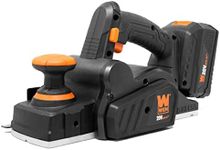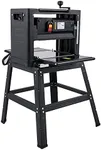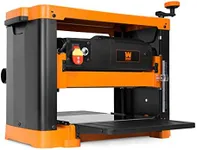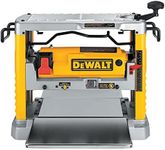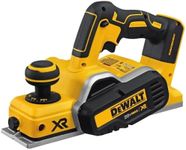Buying Guide for the Best Jet Planers
When choosing a jet planer, it's important to consider your specific needs and the type of work you'll be doing. Jet planers are powerful tools used for smoothing and flattening wood surfaces, and selecting the right one can make a significant difference in the quality and efficiency of your work. Here are some key specifications to consider when picking a jet planer, along with explanations to help you understand their importance and how to choose the best fit for you.Motor PowerMotor power is measured in horsepower (HP) and determines how much force the planer can apply to the wood. A more powerful motor can handle harder woods and larger pieces more efficiently. For light to moderate use, a motor with 1-2 HP is usually sufficient. For heavy-duty or professional use, consider a motor with 3 HP or more. Choose a motor power that matches the intensity and frequency of your woodworking projects.
Cutting WidthThe cutting width refers to the maximum width of wood that the planer can handle in a single pass. This is important because it affects the size of the wood pieces you can work with. Common cutting widths range from 12 to 20 inches. For general woodworking, a cutting width of 12-15 inches is often adequate. If you work with larger pieces of wood, look for a planer with a cutting width of 16 inches or more.
Cutting DepthCutting depth indicates how much material the planer can remove in one pass. This is crucial for efficiency and achieving the desired thickness quickly. Cutting depths typically range from 1/8 inch to 1/4 inch. For most woodworking tasks, a cutting depth of 1/8 inch is sufficient. If you need to remove a lot of material quickly, consider a planer with a deeper cutting depth.
Cutterhead TypeThe cutterhead is the part of the planer that holds the blades and does the actual cutting. There are two main types: straight knife and helical. Straight knife cutterheads are more common and less expensive, but they can be noisier and require more maintenance. Helical cutterheads are quieter, produce a smoother finish, and have replaceable carbide inserts, but they are more expensive. Choose a cutterhead type based on your budget and the quality of finish you need.
Feed RateFeed rate is the speed at which the wood is fed through the planer, usually measured in feet per minute (FPM). A higher feed rate allows for faster work, but may result in a rougher finish. Lower feed rates provide a smoother finish but take more time. Many planers offer adjustable feed rates, allowing you to balance speed and finish quality based on your project requirements. Consider a planer with adjustable feed rates for greater versatility.
Dust CollectionDust collection is an important feature for maintaining a clean and safe workspace. Planers produce a lot of wood shavings and dust, so having an effective dust collection system can make a big difference. Look for planers with built-in dust ports that can be connected to a shop vacuum or dust collection system. This will help keep your work area clean and reduce the risk of respiratory issues.
Build Quality and DurabilityThe build quality and durability of a jet planer are crucial for long-term use and reliability. Look for planers made from high-quality materials like cast iron and steel, which provide stability and reduce vibrations. Check for user reviews and manufacturer reputation to ensure the planer is built to last. Investing in a durable planer will save you money and frustration in the long run.
